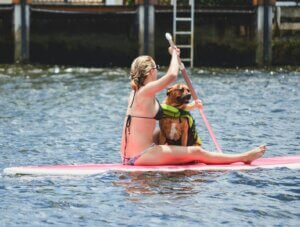Taking your furry friend for walks and exercise is not only crucial for his physical health, but also for his overall well-being. But the question begs: how often should you take your dog for walks and exercise? It’s important to strike the right balance between keeping him active and avoiding overexertion. In this article, we will explore the ideal frequency for taking your dog out, considering factors such as breed, age, and energy level. So, whether you have a high-energy hound or a laid-back lapdog, we have the answers to ensure your dog gets the exercise he needs to live a healthy and happy life.
Determining Factors
Determining how often to take your dog for walks and exercise depends on various factors, including their size and breed, age and health, energy level, and individual needs. By considering these factors, you can create a tailored exercise routine that suits your dog’s specific requirements and ensures they stay healthy and happy.
Size and Breed
The size and breed of your dog are crucial factors in determining how often they should be exercised. Smaller dogs, such as Chihuahuas or Pomeranians, generally require less exercise compared to larger breeds like Golden Retrievers or German Shepherds. Small breed dogs typically have lower energy levels and shorter stamina, so shorter, more frequent walks are usually sufficient for them.
On the other hand, larger breeds tend to have higher energy levels and require more exercise to maintain good health. Engaging them in longer walks, vigorous play sessions, or activities like swimming can help burn their excess energy and keep them physically fit.
Age and Health
Considering your dog’s age and health is essential when determining their exercise needs. Puppies, adult dogs, and senior dogs all have different requirements. Additionally, any existing health conditions your dog may have should be taken into account to prevent overexertion or potential injuries.
Energy Level
Every dog has a different energy level, regardless of their size or breed. Some dogs have naturally high energy levels and require more exercise to keep them stimulated, while others may have lower energy levels and can be content with less intense activity.
Understanding your dog’s energy level will help you gauge how much exercise they need. Observing their behavior and consulting with a veterinarian can provide valuable insights into creating an exercise routine that adequately meets their energy requirements.
Individual Needs
Lastly, it’s important to acknowledge that every dog is unique, and their individual needs should be considered when determining their exercise routine. Some dogs may have special needs due to factors like temperament, anxiety, or specific training requirements. Taking these individual needs into account will enable you to tailor their exercise program to ensure it suits your dog’s specific requirements.
General Guidelines
While the specific exercise routine for your dog will vary based on their size, breed, age, and individual needs, there are some general guidelines that can help you establish a solid foundation for their exercise regimen. These guidelines include considerations for daily exercise, the frequency, duration, and intensity of walks, and the overall intensity of exercise.
Daily Exercise
Regardless of your dog’s specific needs, it’s essential to provide them with daily exercise. Exercise not only helps maintain their physical health but also contributes to their mental well-being. Aim for a minimum of 30 minutes to an hour of exercise per day, but remember that this can vary depending on the factors mentioned earlier.
Frequency of Walks
Determining how often you should take your dog for walks depends on their energy level and exercise requirements. Some dogs may benefit from multiple short walks throughout the day, while others may prefer a longer walk once or twice a day. Observe your dog’s behavior to gauge their energy levels and adjust the frequency of walks accordingly.
Duration of Walks
The duration of walks will depend on your dog’s age, health, and stamina. Generally, aim for walks that last between 30 minutes to an hour. However, keep in mind that younger puppies and older, senior dogs may require shorter walks due to their lower stamina or potential joint issues.
Intensity of Exercise
The intensity of exercise can vary based on your dog’s needs. While some dogs may enjoy a leisurely stroll, others may thrive on more vigorous activities like running or playing fetch. Adjust the intensity of exercise based on your dog’s energy levels, age, and overall fitness level. It’s important to gradually increase the intensity of exercise to avoid fatigue or potential injuries.
Puppies
Puppies have unique exercise requirements that differ from adult dogs. Their growing bodies and developing joints require careful consideration to prevent any potential damage. Here are some guidelines for exercising your puppy:
Limited Exercise
Puppies should not engage in excessive or strenuous exercise that can potentially harm their growing bodies. Avoid activities like long runs or prolonged periods of vigorous play. Instead, focus on shorter, more frequent walks and age-appropriate activities that provide mental stimulation and help build their muscles gradually.
Short Frequent Walks
To keep your puppy active and provide them with the necessary exercise, opt for short walks multiple times a day. Puppies have high energy levels and may require more frequent breaks and shorter distances to prevent exhaustion. Gradually increase the length of the walks as your puppy grows.
Playtime and Mental Stimulation
In addition to walks, puppies also need ample playtime and mental stimulation to keep them entertained and engaged. Incorporate interactive toys, puzzle games, and short training sessions to challenge their minds. This will not only help tire them out but also contribute to their overall development and socialization.
Adult Dogs
Adult dogs typically have settled into their physical development and have more stamina than puppies. Here are some guidelines to consider when exercising your adult dog:
Regular Exercise Routine
Establishing a regular exercise routine is essential for adult dogs. Consistency in their exercise schedule will help them maintain their physical fitness and overall well-being. Set aside specific times each day for exercise to create a structured routine that your dog can rely on.
Sufficient Physical Activity
Adult dogs require more exercise compared to puppies due to their higher energy levels. Aim for a balance of activities such as walks, runs, and play sessions that provide both physical and mental stimulation. Consider your dog’s breed and energy level when determining the intensity and duration of exercise.
Structured Walks
Walking your adult dog is a wonderful opportunity for bonding and exercise. Opt for structured walks where your dog walks by your side, following basic training commands. This not only provides physical exercise but reinforces obedience and proper leash manners. Choose routes with different smells, sights, and terrains to keep your dog mentally stimulated during walks.
Senior Dogs
Senior dogs require particular attention when it comes to exercise. Their bodies may not be as resilient as they once were, and they may have specific health issues that need to be taken into consideration. Here are some guidelines for exercising your senior dog:
Adapted Exercise Routine
Adjusting your senior dog’s exercise routine is crucial to accommodate any age-related limitations or health conditions they may have. Consult with your veterinarian to determine any specific restrictions or recommendations based on your dog’s health status. Modify their exercise routine accordingly to ensure their safety and comfort.
Gentle Activities
Senior dogs may have reduced stamina and joint issues, so it’s important to engage them in gentle activities that won’t cause strain or discomfort. Slow-paced walks, swimming, or gentle stretching exercises can help maintain mobility and prevent stiffness. Focus on low-impact, senior-specific exercises that promote overall well-being.
Shorter Walks
While regular exercise is still important for senior dogs, the duration of their walks may need to be reduced. Older dogs may struggle with longer distances, so opt for shorter, more frequent walks that are better suited to their physical abilities. Pay attention to any signs of fatigue or discomfort, and adjust the walks accordingly.
Working and Sporting Dogs

Working and sporting dogs are often highly energetic breeds with specific exercise requirements to keep them physically and mentally satisfied. Here are some guidelines for meeting the exercise needs of these active dogs:
High Exercise Demands
Working and sporting dogs have significantly higher exercise demands compared to other breeds. They were bred for specific tasks and usually have exceptional stamina. Providing them with ample exercise is essential to prevent boredom and destructive behavior.
Daily Long Walks
Long walks are a great way to meet the exercise needs of working and sporting dogs. Aim for at least one or two long walks each day, allowing them to explore their surroundings and fulfill their natural instincts. Consider incorporating off-leash or supervised free-running sessions in safe and secure areas to allow them to burn off their excess energy.
Mental Stimulation
In addition to physical exercise, working and sporting dogs also require significant mental stimulation. Engage them in activities like obedience training, agility classes, or scent work to keep their minds occupied and challenged. Mental enrichment can be just as tiring for these breeds as physical exercise, helping to maintain their overall well-being.

Small Breed Dogs
While small breed dogs may not require as much exercise as larger breeds, they still need regular physical activity to stay healthy. Here are some guidelines for providing exercise to small breed dogs:
Energy Levels
Small breed dogs often have higher energy levels compared to their larger counterparts. These lively little dogs benefit from regular exercise to burn off their excess energy and prevent behavioral issues that can arise from boredom.
Active Playtime
In addition to daily walks, small breed dogs can benefit from active playtime sessions. Engage them in games like fetch, hide-and-seek, or providing puzzle toys that stimulate their minds and keep them physically active. Regular playtime helps maintain their muscle tone and contributes to their overall well-being.
Balanced Exercise Routine
Balancing exercise and rest is important for small breed dogs. These dogs may tire quickly due to their small size, so it’s crucial not to overexert them. Opt for shorter walks and play sessions that are appropriate for their energy levels and provide them with plenty of opportunities to rest and recover.
Medium and Large Breed Dogs
Medium and large breed dogs have different exercise needs compared to smaller breeds. Here are some guidelines for exercising medium and large breed dogs:
Physical Activity Needs
Medium and large breed dogs generally have higher exercise requirements due to their size and energy levels. They benefit from daily exercise to prevent boredom, obesity, and behavioral issues resulting from pent-up energy. Make sure to engage them in activities that suit their size and physical abilities.
Engaging Walks and Play
 Providing medium and large breed dogs with engaging walks and play sessions is essential for their well-being. Opt for varied routes during walks to expose them to different environments and smells. Incorporate mentally stimulating activities like scent work or obedience training during play sessions to keep their minds engaged and active.
Providing medium and large breed dogs with engaging walks and play sessions is essential for their well-being. Opt for varied routes during walks to expose them to different environments and smells. Incorporate mentally stimulating activities like scent work or obedience training during play sessions to keep their minds engaged and active.
Supervised Free Running
Medium and large breed dogs often benefit from free running sessions in safe and secure areas. Off-leash playtime allows them to stretch their legs, sprint, and burn off their excess energy. Ensure these sessions are conducted in a controlled environment and always under supervision to ensure their safety.
Highly Energetic Breeds
Some breeds are known for their exceptionally high energy levels and require specialized exercise routines. Here are some guidelines for exercising highly energetic breeds:
Intense Exercise Sessions
Highly energetic breeds like Border Collies, Australian Shepherds, or Siberian Huskies require intense exercise to meet their needs. They thrive on activities that challenge their physical and mental limits. Engage them in activities like agility training, herding trials, or flyball to provide the intense exercise they require.
Mental Enrichment
Physical exercise alone may not be sufficient to tire out highly energetic breeds. Mental enrichment is equally important for these breeds to keep their minds occupied and prevent boredom. Consider providing them with puzzle toys, interactive games, or obedience training to keep them mentally stimulated.
Specialized Activities
Some highly energetic breeds excel at specialized activities that cater to their natural instincts. For example, herding breeds may enjoy herding trials or participating in dog sports like dock diving or lure coursing. Understanding your dog’s breed-specific needs can help you identify specialized activities that provide appropriate exercise and mental stimulation.
Overweight and Obese Dogs
If your dog is overweight or obese, exercise plays a vital role in helping them shed those excess pounds and regain their health. Here are some guidelines for exercising overweight and obese dogs:
Gradual Increase in Activity
When starting an exercise routine for an overweight or obese dog, it’s important to start gradually to avoid excessive strain or injury. Begin with shorter, low-impact activities like gentle walks or swimming. Gradually increase the duration and intensity of exercise as your dog’s fitness improves.
Controlled Diet
Exercise alone may not be sufficient to help your overweight or obese dog lose weight. A controlled diet that is tailored to their specific needs is crucial. Consult with your veterinarian to create a balanced diet plan that supports weight loss and complements their exercise routine.
Low Impact Exercises
Overweight and obese dogs are at higher risk of joint problems, so engaging them in low-impact exercises is essential. Activities like swimming or walking on soft surfaces can help reduce stress on their joints while still providing the necessary exercise. Be mindful of your dog’s comfort level and adjust the activities as needed.
In conclusion, determining how often to take your dog for walks and exercise requires considering a variety of factors such as size and breed, age and health, energy level, and individual needs. By tailoring their exercise routines to meet these specific requirements, you can ensure your furry friend remains healthy, happy, and well-exercised. Remember to consult with your veterinarian for personalized guidance and advice to create an exercise plan that suits your dog’s unique needs.






